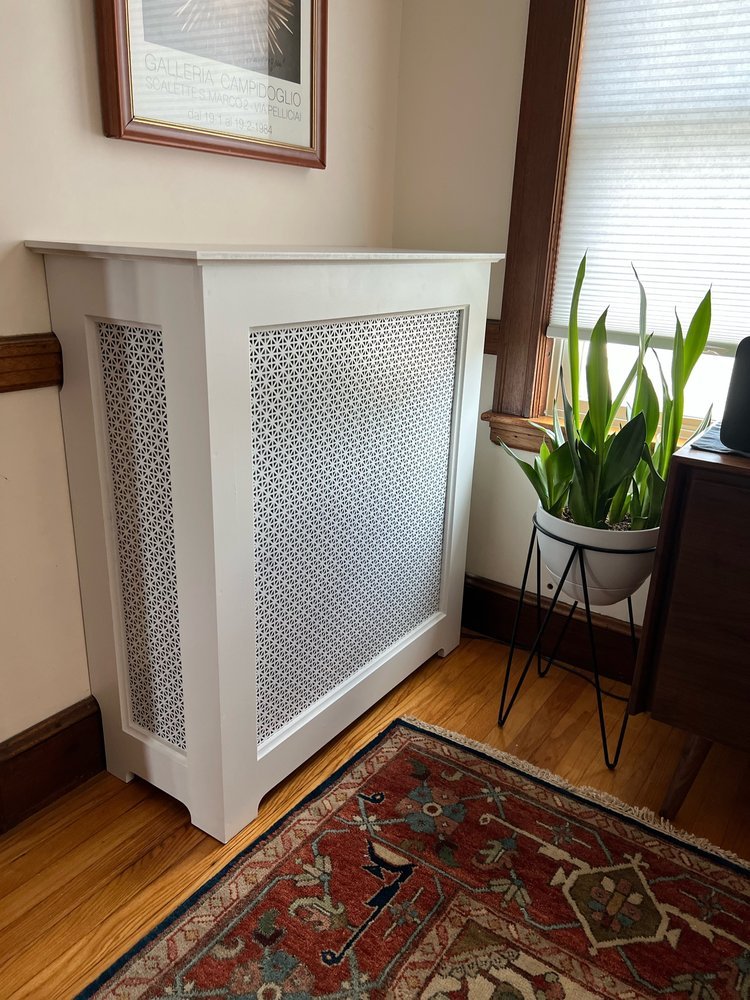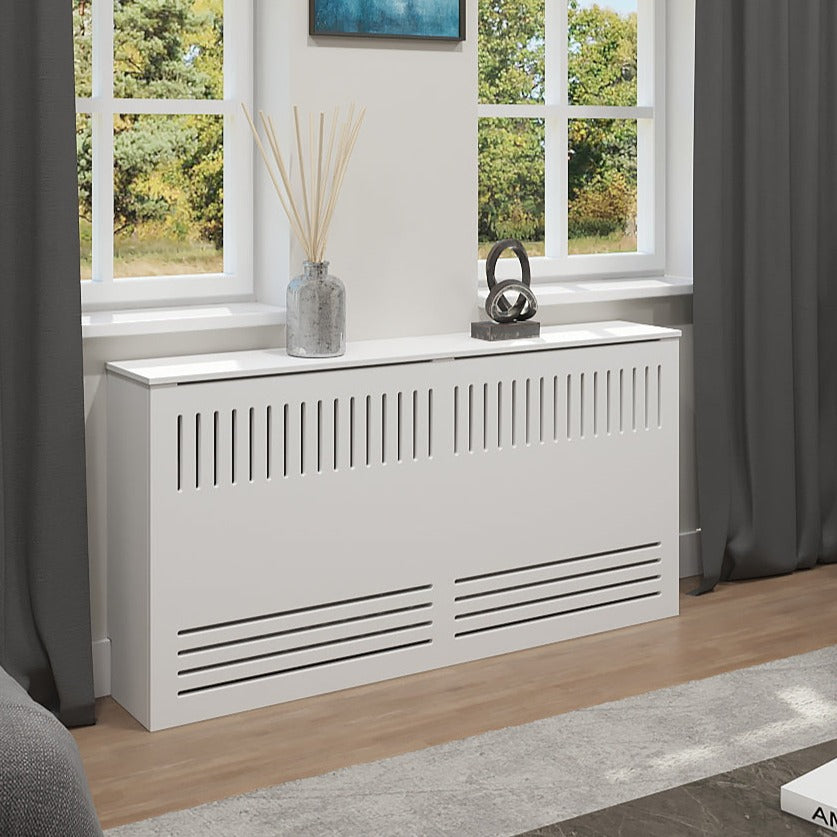How to Clean and Maintain Your Custom Radiator Covers for Long-Term Beauty
Key Features to Take Into Consideration When Choosing Custom Radiator Covers for Your Space
Selecting custom-made radiator covers entails several crucial variables. Material toughness is vital for durability, while style needs to integrate with the existing decoration. Size fit is essential for capability and aesthetic appeals. In addition, factors to consider around heat performance and air flow can influence performance. Nonetheless, the nuances of setup and upkeep frequently continue to be ignored. Comprehending these aspects will lead you toward a notified choice that enhances your room effortlessly. What other aspects should be thought about?

Material Options for Customized Radiator Covers
When selecting personalized radiator covers, the selection of products plays a crucial role in both aesthetics and functionality. Various products are available, each with one-of-a-kind residential properties that deal with different needs. Timber, for circumstances, supplies a timeless appearance and can be easily personalized, but it may be susceptible to buckling in high moisture. Metal choices, such as aluminum or steel, provide toughness and warm resistance, making them suitable for high-heat environments. custom radiator covers.For those looking for a modern touch, MDF (medium-density fiberboard) is a preferred choice; it can be repainted or ended up to match any type of style while staying affordable. In addition, some may opt for acrylic, which enables innovative layouts and transparency, although it might not be as heat-resistant. Inevitably, the choice of material significantly impacts not just the cover's look but likewise its durability and efficiency in efficiently taking care of warmth outcome
Layout Designs to Match Your Home Decoration
Although radiator covers offer a functional objective, their design can substantially improve the total aesthetic of an area. Home owners can pick from various styles to seamlessly incorporate these covers into their existing decoration. For a modern appearance, smooth metal or minimal wood styles provide a clean, contemporary ambiance. In contrast, standard homes may gain from ornate wood covers with detailed makings that mirror traditional craftsmanship.Farmhouse styles often integrate rustic elements, utilizing reclaimed timber for a warm, inviting touch. For those who prefer a diverse technique, vibrant shades and patterns can be employed to produce a statement item that attracts the eye.Additionally, incorporating ornamental grilles or open layouts can permit air movement while adding visual passion. Picking a design that enhances the general theme of the home warranties that the radiator cover ends up being not simply a practical aspect however additionally a fashionable focal point within the area.
Size and Fit Factors To Consider
Exactly how can property owners guarantee their personalized radiator covers fit perfectly within their rooms? Precise dimensions are necessary for attaining a seamless fit. Homeowners need to start by gauging the length, size, and height of their radiators, thinking about any kind of extending elements such as valves or pipelines. In addition, it is important to take into consideration the surrounding room, ensuring that the cover does not block airflow or hinder furnishings placement.Choosing the right product and layout can also influence fit; for example, some products might require details thicknesses to assure sturdiness. Property owners ought to additionally consider the desired style of the area, making certain that the cover enhances existing decor while fitting pleasantly in the assigned location. A well-measured and thoughtfully created cover not just boosts appearances but also guarantees reliable home heating by permitting correct air flow around the radiator.
Setup Refine and Needs
To guarantee a successful installment of custom-made radiator covers, careful planning and attention to detail are vital. First, one need to precisely gauge the radiator measurements and surrounding area to verify a correct fit. Next, selecting the appropriate materials is necessary; options may include timber, metal, or composite products, each needing particular devices and techniques for installation.Before starting the installment, it is recommended to gather all required tools, such as screwdrivers, braces, and drills, to streamline the procedure. The installation location must be free from obstacles for safety and efficiency.Once ready, the custom covers can be firmly installed, ensuring that they are leveled and lined up correctly. Adhering to maker guidelines during this stage is essential to prevent any type of structural problems. Finally, a thorough inspection ought to be conducted to confirm that the covers are safely attached and aesthetically appealing, contributing to the total aesthetic of the space.
Warm Performance and Airflow
When choosing custom-made radiator covers, warm efficiency and air flow are essential variables to contemplate. Proper air flow style assurances ideal warm circulation throughout a space, making best use of and avoiding chilly places convenience. Interest to these elements can substantially improve the general efficiency of a furnace.
Ideal Warm Circulation
Perfect warmth distribution is important for preserving a comfy interior setting, and personalized radiator covers can significantly boost this procedure. custom radiator covers. These covers are created not just for aesthetic appeals yet additionally to maximize warm performance. By guiding cozy air efficiently throughout the area, they protect against cold places and ensure that heat circulates uniformly. Properly made covers can assist in air movement while decreasing obstruction, allowing warm air to increase and distribute naturally. Furthermore, the materials made use of in custom-made radiator covers can affect warm retention and outcome. Choosing covers that stabilize style and capability is necessary, as they can add significantly to a home's general heating performance, enhancing convenience and possibly decreasing power costs in the lengthy run
Air Flow Style Considerations
Reliable ventilation design is vital for guaranteeing perfect warmth efficiency and air movement precede with radiator covers. When selecting a personalized cover, it is crucial to take right into account attributes that help with unhampered air motion. Grilles and vents should be purposefully positioned to permit cozy air to flow openly while protecting against getting too hot. Additionally, the material of the cover can affect airflow; light-weight materials commonly advertise better ventilation compared to larger alternatives. The style needs to also account for maintaining optimal ranges between the cover and radiator to boost efficiency. Eventually, a properly designed radiator cover will certainly not just boost the aesthetic appeal of a space however additionally contribute to effective home heating, creating a much more comfy atmosphere.
Customization and Personalization Attributes

Upkeep and Care Tips for Longevity
Keeping custom radiator covers is important for their long life and look. Regular cleaning practices, using ideal cleansing remedies, and seasonal evaluations can substantially boost their resilience. Carrying out these read review treatment ideas assures that the covers stay functional and aesthetically appealing in time.
Regular Dusting Practices
On a regular basis cleaning custom radiator covers is crucial for protecting their look and capability. Dirt accumulation can block airflow, potentially impacting the radiator's effectiveness. It is advisable to carry out a consistent dusting timetable, ideally when a week, to stop build-up. A soft microfiber cloth or a duster is advised for this task, as these materials successfully catch dirt without scraping the surface area. Treatment needs to be required to clean the locations bordering the radiator cover too, guaranteeing that no dust is entrusted to clear up. For homes with family pets or high foot website traffic, even more frequent dusting might be necessary. This simple maintenance technique not just improves the see here visual appeal yet also contributes to the durability of the radiator cover.
Ideal Cleaning Up Solutions
Selecting proper cleansing remedies is vital for the durability of customized radiator covers. House owners must select mild, non-abrasive cleaners to stop damage to the surface finish. Mild soap blended with cozy water is often effective for general cleansing, while staying clear of extreme chemicals that might strip the material. A soft fabric or sponge is recommended for application, ensuring that no gritty products are utilized that might scratch the cover. It's essential to dry out the cover completely after cleaning to avoid moisture accumulation, which can lead to corrosion or mold. Normal upkeep with appropriate cleaning items not only enhances the look of the radiator covers yet additionally prolongs their life expectancy, ensuring they remain a visual and practical component of the space.

Seasonal Evaluation Tips
Custom-made radiator covers are made for durability, conducting seasonal evaluations is essential for guaranteeing they continue to be in optimal condition. Home owners must begin by examining for any type of indications of damage, such as dents, scrapes, or corrosion. Additionally, confirming that the cover fits well and safely around the radiator is essential, as loosened fittings can bring about inefficiencies. Throughout evaluations, dirt and debris need to be eliminated to avoid buildup that can block airflow. Inspecting for moisture or mold and mildew is critical, as these can endanger the cover's honesty. Ultimately, analyzing the paint or surface for wear permits prompt touch-ups, boosting both appearances and durability. Normal assessments aid keep efficiency and appearance while lengthening the lifespan of custom-made radiator covers.
Regularly Asked Concerns
Can I Make Use Of Personalized Radiator Covers in Outdoor Spaces?
The question of using personalized radiator covers in outdoor spaces occurs often. Normally, these covers are made for interior usage, as exterior problems can impact and damage materials functionality, making them improper for exterior settings.
What Is the Ordinary Price of Custom Radiator Covers?
The ordinary expense of customized radiator covers generally varies from $200 to $800, depending upon materials, size, and style intricacy. House owners must consider their spending plan and visual choices when making a decision.
Are There Eco-Friendly Material Options Available?
The inquiry relating to green material choices revealed that numerous lasting products, such as recovered timber, bamboo, and recycled steels, are offered for custom radiator covers, interesting ecologically conscious customers looking for responsible and stylish home solutions.
How Do I Clean Elaborate Layouts on Radiator Covers?
Cleansing complex layouts on radiator covers calls for a mild technique. Soft cloths or learn the facts here now brushes with light soap and water can effectively get rid of dust and crud, ensuring that the delicate details remain undamaged while preserving the cover's look.
Do Customized Radiator Covers Reduce Sound From the Heating System?
Custom-made radiator covers can help decrease sound from furnace by moistening resonances and sound. Their design typically consists of shielding products, which additionally minimizes audio transmission, developing a quieter and much more comfortable environment in the space. When choosing personalized radiator covers, the option of products plays a crucial function in both visual appeals and performance. In addition, the products used in custom-made radiator covers can impact warmth retention and result. Reliable air flow style is crucial for making sure ideal warm effectiveness and airflow in rooms with radiator covers. Custom radiator covers are designed for toughness, performing seasonal inspections is essential for ensuring they continue to be in ideal condition. The typical cost of custom-made radiator covers commonly ranges from $200 to $800, depending on materials, dimension, and design complexity.